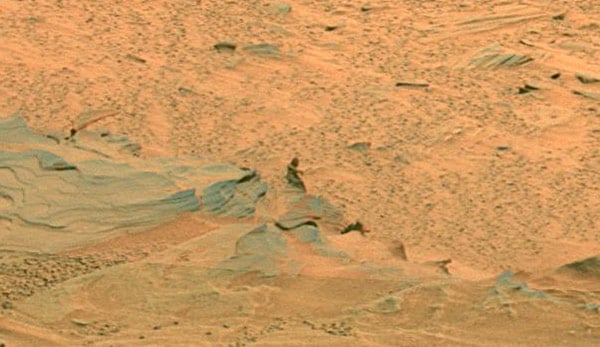Mars is the fourth planet from Sun, and the last of the inner planets. Mars is about half the size of Earth and has two moons, Phobos and Deimos. Its surface is red due to the oxidation of iron in the soil. The Martian atmosphere is 100 times less dense than that of Earth and primarily made up of Carbon Dioxide. Although Mars does have seasons, the temperature only varies from cold to extremely cold.

The earth-based observations of Mars paved the way for spacecraft exploration of the planet. So many questions had been raised about Mars and there were so few answers. Did life exist on Mars in the past or present? Was water present on the planet? If so, what form was it in? What was the atmosphere composed of and what were its dynamics? Could Mars be used to tell us more about the evolution of both Earth and our solar system?
The combination of the thin atmosphere and low temperatures make it impossible for water to exist as a liquid on the surface of Mars. It would either freeze or evaporate. The Carbon Dioxide, which freezes to form Northern and Southern Polar caps, also exists only in solid and gaseous states, leaving the possibility that there is no liquid on Mars (at least at the surface). There are, however, many features on the surface of Mars which appear to have been created by great volumes of liquid. The current lack of water and erosion by liquids on Mars has kept the surface nearly unchanged for billions of years. This offers geologists a look into the ancient past of the planet as they view craters, volcanoes and canyons. If there was liquid water to form the distinct features on Mars that means that there was a medium in which life could develop. Only recently have we found the first evidence for life on Mars, in the ALH meteorite. The study of the origin of life on our planet and others, called exobiology, is of great interest to many scientists.
Mars is smaller and, because of its greater distance from the Sun, cooler. It has seasons similar to Earth's because the tilt of its rotational axis (axial inclination) to the plane of its orbit about the Sun is about the same as Earth's. Interestingly, unlike Earth the significant eccentricity (elliptical shape) of the martian orbit means that the seasons on Mars are also affected by varying distance from the Sun. In the case of Earth, because of its almost circular orbit, our seasons result simply from the tilt of the Earth's rotation axis.
The mean distance of Mars to the Sun is about 228 million kilometers. As noted above, the martian orbit is quite eccentric which leads to a difference of nearly 42 million kilometers between the furthest distance from the Sun (called "aphelion") and the closest distance ("perihelion"). As for any body in a gravitationally bound orbit, Mars travels more swiftly in its orbit when it is close to the Sun than when it is distant. As a result the duration of the four martian seasons varies one from another, unlike the case on Earth where each season lasts for just one quarter of the year.
According to Newton's gravitational law, the velocity of Mars is maximum at perihelion and minimum at aphelion, thus the duration of seasons shows an important variability. In the Martian northern hemisphere, winter is short and relatively "mild" while summer is long and cool. Conversely for the southern hemisphere summer is short and relatively hot while winter is long and cold. Currently, the North Pole is inclined away from the sun at perihelion but the situation goes through a cycle every 75.000 years.

The energy received by the Martian surface over the year is in direct proportion to the orbital eccentricity. The eccentricity is not fixed but, is under the gravitational influence of the other planets (especially Jupiter). The eccentricity cycles and at times the orbit is more circular. As the planet changes from an elliptic orbit to a quasi-circular one, the energy balance strongly differs from one epoch to another. There would be "warm periods" where increased sublimation of polar CO2 ice would lead to the release of more gas into the atmosphere, thus to a greater atmospheric pressure. As the inclination of the planetary spin axis is also subject to significant cyclic variation, it is suspected that the distribution of surface heating by the Sun should have experienced cyclic change over the millenia. This cycling of the martian orbit and of its spin axis make Mars an unusually variable planet. Thus Mars may well once have been quite different from the way we see the planet today.


No comments:
Post a Comment